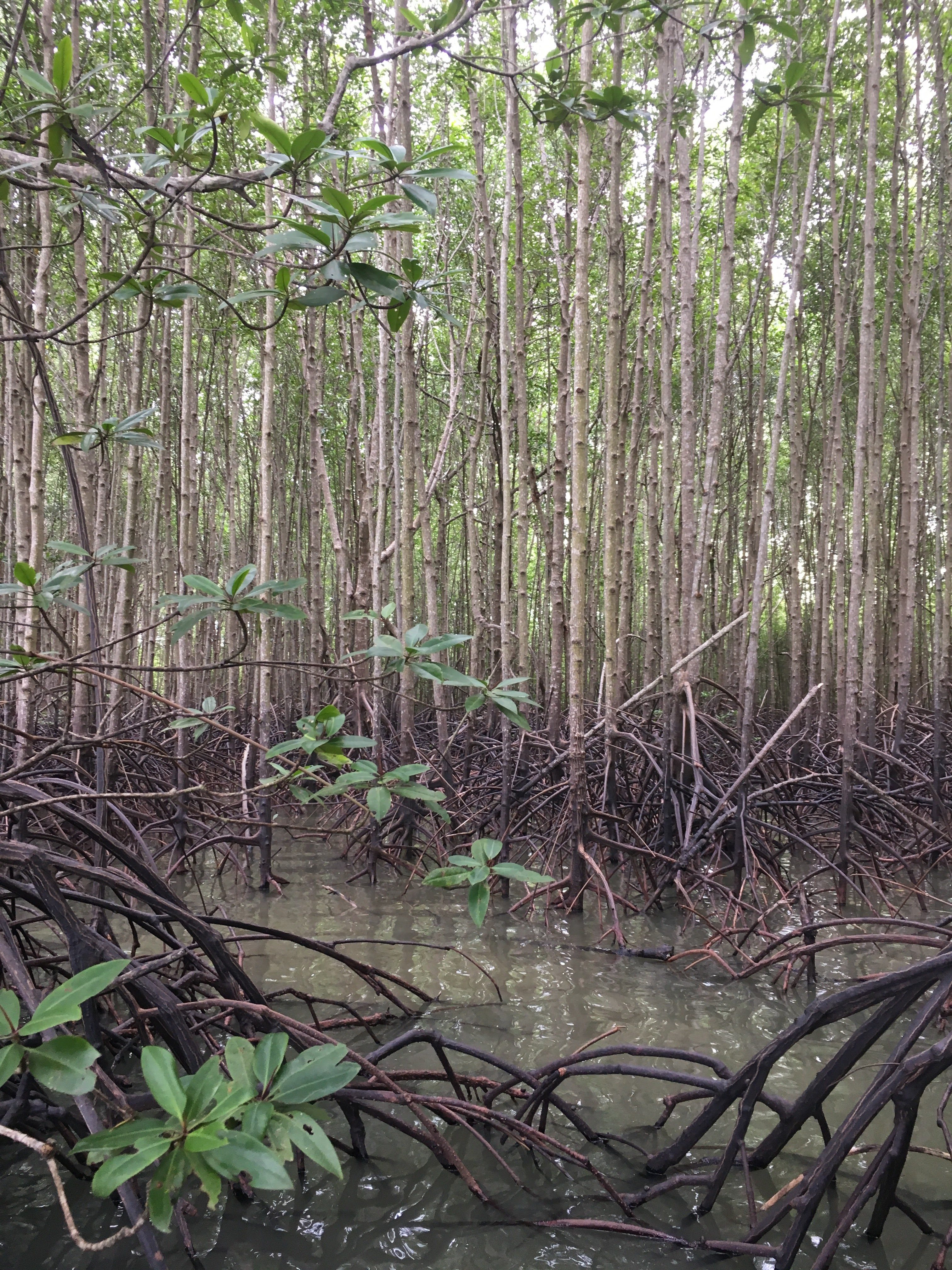Mangrove forests are comprised of intertidal trees and shrubs that are found on tropical and sub-tropical coastlines. [1] [2] [3] In 2011, a study by Giri et al., showed the greatest proportion of mangrove forests in the world are located in tropical regions between 5° North and 5° South latitude.[4] This compliments prior studies that geographically positions mangroves within approximately 30° North and 30° South latitude.[5] [6] [7] [8] Mangroves grow in a variety of forest types that can generally be classified into basin, fringe and estuarine [9] [10] and these littoral woodlands encompass approximately 70 tree species. [5] [11]
Fringe mangroves are geographically located on the coastline. They are found in stands approximately 10-12 metres high and these forests are usually impacted by waves, wind, storm surges, tidal change and flushing.[12] [13] [14] Secondly, basin mangrove forests can be found in close proximity to lagoons and mudflats that are further inland at depressions where water levels fluctuate due to seasonal (wet and dry) variation. Basin mangrove trees can have heights ranging between 3-12 metres. [12] [13] Finally, the estuarine (riverine) mangrove forests align tidal river banks and creeks. These forests experience the greatest productivity and tree growth due to increased nutrients, tidal flushing and litter fall as compared to basin and fringe. Riverine forests can extend kilometres inland and they are not exposed to waves, and storm surges therefore facilitating an environment where forest stands can reach as high as 35 metres.[12] [13] At each type of mangrove forests various species of mangrove trees can be found which are classified into 3 primary groups which include red, black and white mangroves.
Red mangroves (Rhizophora mangle) are found on the boundaries of coastline locations and are impacted directly by waves and storm surges. They are characterised by their interconnected red prop roots that extend approximately 1 metre from the trunk to the soil surface to stabilise the tree. Black mangroves (Avicennia germinans) are found at greater heights on the coastline where tidal changes expose the pneumatophores to the air. Pneumatophores are pencil-shaped prop like roots that extend vertically from the subsurface to a height approximately 10-20 cm and submerged horizontal root systems to provide oxygen to the tree. [15] [16] [17] Finally, white mangroves (Laguncularia racemosa) are found at higher elevations as compared to black and red mangroves. White mangrove root systems are underground and do not possess prop roots or pneumatophores. However, in flooded or oxygen deprived areas they may develop peg roots.[17]
Why are mangroves important?
Mangrove forests provide a host of ecosystem services (ES) as classified and mainstreamed by the Millennium Ecosystem Assessment (MA) which include provisioning, supporting, regulating and cultural services.[18] [19] [20] Provisioning services provided by mangroves include food, timber, fuel and medicine. The regulating services include water purification, carbon sequestration and sinks, coastal protection from storm surges and salt water intrusion, flood and erosion control. The supporting services include a habitat for biodiversity, breeding and nursery grounds for commercial fish species and other wildlife. Finally, the cultural services include aesthetics, tourism, recreation, education and research.[11] [21] [22] The aforementioned examples of ES provided by mangroves refer to some of the major benefits humans receive from these forests.
Featured Image courtesy: Angie Elwin taken in Trat, Thailand
[1] Friess, D. (2016). Mangrove forests. Current Biology, 26(16), pp.R746-R748.
[2] Hogarth, P. 2007. The Biology of Mangroves and Seagrasses: Second Edition. Oxford University Press. UK
[3] NOAA. (2018). What is a “mangrove” forest?. [online] Available at: https://oceanservice.noaa.gov/facts/mangroves.html.
[4] Giri, C., Ochieng, E., Tieszen, L., Zhu, Z., Singh, A., Loveland, T., Masek, J. and Duke, N. (2011). Status and distribution of mangrove forests of the world using earth observation satellite data. Global Ecology and Biogeography, 20(1), pp.154-159.
[5] Spalding MD, Blasco F, Field CD. 1997. World Mangrove Atlas. Okinawa (Japan): International Society for Mangrove Ecosystems.
[6] Valiela, I., Bowen, J. and York, J. (2001). Mangrove Forests: One of the World’s Threatened Major Tropical Environments. BioScience, 51(10), p.807.
[7] Alongi, D. (2009). The energetics of mangrove forests. [Place of publication not identified]: Springer.
[8] Luther, D. and Greenberg, R. (2009). Mangroves: A Global Perspective on the Evolution and Conservation of Their Terrestrial Vertebrates. BioScience, 59(7), pp.602-612.
[9] Lugo, A., Brown, S. and Brinson, M. (1988). Forested wetlands in freshwater and salt-water environments. Limnology and Oceanography, 33(4part2), pp.894-909.
[10] Ewel, K., Twilley, R. and Ong, J. (1998). Different Kinds of Mangrove Forests Provide Different Goods and Services. Global Ecology and Biogeography Letters, 7(1), p.83.
[11] Alongi, D. (2002). Present state and future of the world’s mangrove forests. Environmental Conservation, 29(3), pp.331-349.
[12] Mangrove. (n.d.). Mangrove forests. [online] Available at: http://www.mangrove.at/mangrove_forests.html [Accessed 14 Feb. 2019].
[13] USGS. (n.d.). Macrogroup Detail Report: M005. [online] Available at: https://www1.usgs.gov/csas/nvcs/nvcsGetUnitDetails?elementGlobalId=838396 [Accessed 21 Feb. 2019].
[14] Mooney, H. (1996). Functional roles of biodiversity. Chichester: Wiley.
[15] Katherisan, K. and Bingham, B. (2001). Biology of mangroves and mangrove ecosystems. Advances in Marine Biology, 40, pp.81-251.
[16] Hogarth, P. (2013). Mangrove Ecosystems. Encyclopedia of Biodiversity, 5.
[17] Florida Museum. (2019). Mangrove Species Profiles. [online] Available at: https://www.floridamuseum.ufl.edu/southflorida/habitats/mangroves/species/ [Accessed 10 Feb. 2019].
[18] Millennium Ecosystem Assessment, 2003. Ecosystems and human well-being : a framework for assessment. Island press. Washington DC.
[19] Millennium Ecosystem Assessment, 2005. Ecosystems and Human Well-being: Synthesis. Island Press, Washington, DC.
[20] TEEB (The Economics of Ecosystems and Biodiversity). (2010). Ecosystem Services – TEEB. [online] Available at: http://www.teebweb.org/resources/ecosystem-services/ [Accessed 20 Sep. 2018].
[21] Barbier, E., Hacker, S., Kennedy, C., Koch, E., Stier, A. and Silliman, B. (2011). The value of estuarine and coastal ecosystem services. Ecological Monographs, 81(2), pp.169-193.
[22] Brander, L.M., Wagtendonk, A.J., Hussain, S.S., McVittie, A., Verburg, P., de Groot, R. and van der Ploeg, S. (2012). Ecosystem service values for mangroves in Southeast Asia: A meta-analysis and value transfer application. Ecosystem Services, 1(1), pp.62-69.

